17 The Coaching Association of Canada’s Journey Towards Safer Sport
Julie Stevens
Isabelle Cayer
Peter Niedre
Themes
Coach Training
Coach Education
Safe Sport Journey
Learning Objectives
When you have completed this chapter, you will be able to:
LO1 Explain what the CAC is and what its Mission & Values are;
LO2 Identify the role of the coach and sport organizations in the implementation of safe sport practices;
LO3 Identify the role of the CAC in ensuring a safe sport environment;
LO4 Explain the three pillars of the Responsible Coaching Movement; and
LO5 Identify the different coach training and education programs offered by the CAC.
Overview
Wherever there is an athlete, there is a coach. Coaches are parents, teachers, neighbours, and ethical leaders in their communities. They listen to, lead, encourage, and inspire our country’s athletes and participants in every sport and at every level. What motivates someone to become a coach? It’s their passion to help others and themselves to achieve higher goals, both in sport and in life. This chapter explains the mandate and activities of the Coaching Association of Canada (CAC) and what we believe to be the role of coaching in promoting the safe sport movement.
Key Dates
The Coaching Association of Canada: Our Mission & Values
The CAC’s mission is to enhance the experiences of all athletes and participants in Canada through quality coaching; and with its partners are stewards of nation-wide standards and ethics in coach education and development. Yet, the responsibility of ensuring safe sport belongs to more than just coaches. The safe sport movement requires support from sport officials, administrators, volunteers, athletes & participants, health professionals in Integrated Support Teams (ISTs), parents and guardians.
Figure 17.1 Coaching Association of Canada Values

The ever-growing body of research regarding safe sport alongside publicized news stories of athlete maltreatment has influenced the sport system in Canada and around the world to do better. As a result, the CAC has made it one of their core missions to educate sport leaders on safe sport and create a safe and inclusive environment for everyone including athletes, coaches, volunteers, and decision-makers. These decision-makers include sport administrators, officials, CEOs, board chairs and high-performance directors who lead and influence a culture of excellence in sport.
The CAC recognizes sport’s ability to positively impact the lives of Canadians in areas including mental health, physical health, and social change with their vision to inspire the nation through sport. Therefore, the association educates, develops and celebrates the achievement of coaches in Canada from the community level through to high-performance and motivates them to be participant and athlete-centered.
The CAC also unites partners and stakeholders in its commitment to raise the skills and stature of coaches and ultimately expand their reach and influence. We are a partner-driven organization that relies on the strength of its relationships to achieve its mission. The coach and sport leader development and education system in Canada is a result of the work of highly committed individuals from many different organizations who strive for coaching excellence from the playground to the podium. Programming offered by the CAC can empower sport organizations and coaches in Canada with knowledge and skills, it can promote ethical behaviours, foster positive attitudes, build competence and increase the credibility and recognition of coaches.
Video 17.1 Safe Sport Training Promo, CAC
Video provided by Coaching Association of Canada. Used with permission. [Transcript]
Coaching Research
Data and research are of major importance to the CAC. Our research strategy aims to ensure that sport coaching programs are based on evidence-based decision making and are credible. As part of its research strategy, the CAC is developing four interrelated areas of influence. Sport Science and Sport Coaching research informs and inspires the CAC’s programs and services. Sport Science research is at the foundation of the National Coaching Certification Program (NCCP) content, which is in turn transferred to and applied by NCCP coaches. Sport Coaching research is at the foundation of the NCCP learning design as well as of other programs and services targeting Women in Coaching, Diversity and Inclusion, Lifelong Learning and Professional Coaching. The CAC research strategy of knowledge mobilization and dissemination helps inform development of training for coaches and sport leaders in safe sport, and also measures the impact of the training on their self-efficacy.
Figure 17.2 Sport Coaching Research
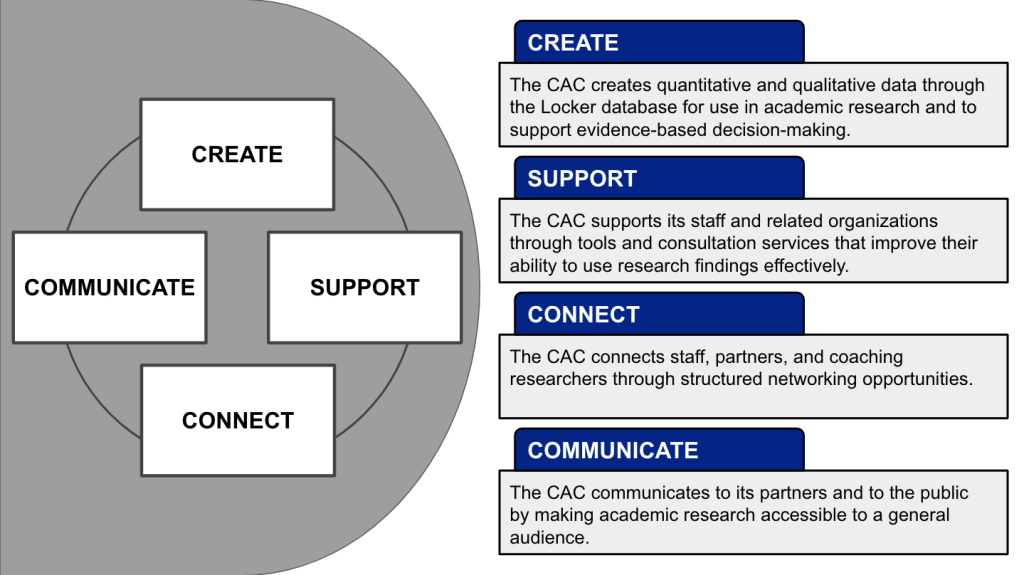
The National Coaching Certification Program
The CAC’s brand equity is built on a 50-year foundation of national and international recognition as the “go to” resource for coaching advice and information. The people who make up the organization believe that every participant deserves a certified coach.
We are mandated by governments to develop a harmonized coaching education program that is available and accessible throughout the country. As part of this mandate, the CAC along with Provincial/Territorial Coaching Representatives (PTCRs), National Sport Organizations (NSOs), and Provincial/Territorial Sport Organizations (PTSOs) share the stewardship of the National Coaching Certification Program (NCCP). The NCCP is the program that delivers coach training and grant certification to coaches and coach developers across 65+ different sports nation-wide.
The CAC produces multi-sport NCCP training content that is delivered by PTCRs and via eLearning. It is committed to enhancing the coaching profession, promoting ethical and responsible coaching practices, and ensuring diversity and inclusion practices are embedded within all coach training and development initiatives.
Because the CAC has numerous categories of partners and stakeholders, we have unique value propositions for each:
- For organizations who engage paid and volunteer coaches, the CAC works in partnership with PTCRs, NSOs and PTSOs to develop and deliver quality coach education, recognize the value of coaches in our community, and advocate for responsible and ethical coaching practices to ensure the safety of athletes and coaches.
- For coaches at every level in Canada for whom coaching is their passion and their profession, the CAC advocates for professional and ethical standards and helps them achieve the highest designation of Chartered Professional Coach (ChPC).
- For athletes, parents, and the public who place the coach in a position of trust, the CAC and its partners establish educational and ethical standards for sport organizations and help create a safe environment for athletes and coaches both on and off the field of play.
- For organizers of major games who need informed and indisputable national standards for coaching staff, the CAC manages the risk of coaching at the games by setting standardized and recognized minimum eligibility requirements on the professional coaches who are eligible to attend the games with their athletes.
- For students whose career aspiration is to become a professional coach and desire the support of those more experienced persons within the profession, the CAC provides access to learning, networking, apprenticeship, co-ops, and directed mentorship opportunities.
Figure 17.3 Pathways to Chartered Professional Coach (ChPC) Designation

Eligibility:
- Education (NCCP Certification+);
- Experience (Coaching);
- Ethics: NCCP Make Ethical Decisions (MED), NCCP Code of Ethics, and Coaching Code of Conduct;
- Safe Sport Training;
- E-PIC (Enhanced police information check); and
- Two professional references.
Why Safe Sport? A Focus on Shifting Culture
It is important to understand the driving factors of safe sport and the cultural renovation that sport is currently facing around the world. For centuries, sport has been a building block of society by creating a sense of belonging between different groups of people. In Canada, sport is deeply rooted in Canadian culture as it allows diverse individuals to share a common ground, communicate through a shared passion, and even reconcile differences. Simply put, sport can change lives. Therefore, we see sport as a catalyst for positive change in the world and are convinced of the importance to protect the people it involves. Culture is about people, and people are increasingly desiring to participate in holistic experiences that serve a greater purpose. This means that it has become even more important for individuals to engage meaningfully with their communities and different organizations. Because of societal shifts like these, the development of sport and the rules that govern it have been directly impacted.
Video 17.2 Isabelle Cayer: Sport is in a Culture Renovation
Video provided by Dr. Michael Van Bussel, Panel Moderator and Conference Chair, 2021 Safe Sport Forum; and Dr. Julie Stevens, Director, Centre for Sport Capacity, Brock University. Used with permission. [Transcript]
According to the basic tenets of the socio-ecological model, everyone has a role to play in the movement towards safe sport. This model demonstrates the overlapping influence that numerous people and organizations have over safe sport outcomes. For example, Register-Mihalik et. al. argue that this model offers different avenues for understanding the interplay between different levels of society and sport, which can be used to provide education towards preventing sport-related concussions.[1] If we use this same model to identify the risk factors in broader safe sport issues, we can better target the ways in which the community beyond the athlete and coach, such as the sport organizers and government legislators, can impact the implementation of safe sport in the years to come.
Figure 17.4 A Socio-Ecological Model to Inform Safe Sport

Athlete Empowerment
Athlete empowerment is critical in understanding the shift from traditional to contemporary sport. Traditionally, athlete voices were absent from conversations in sport as the authority was held by individuals such as coaches, officials, and general managers. This power differential potentially created an unsafe environment for athletes. In some instances, athletes were taught to normalize abusive language, excessive amounts of physical activity as punishment, and in some cases inappropriate or unnecessary touching.[2]
This is not to suggest that all coach-athlete relationships were harmful, but there have been patterns of abuse in the sport system. However, with the proliferation of modern forms of communication such as social media, athletes have begun to acquire their own voice. Social media has created a space for athletes to share their stories of maltreatment and become advocates for change in areas of sport that require attention. In a contemporary sport model, the athlete and coach co-create the expectations and accountability to performance goals.
Psychological Safety
Another contributor to the culture shift that sport currently faces is the push for psychological safety. Traditional coaching followed the concept that the coach is the director of the program and makes the decisions. However, athlete empowerment has fostered a transition towards a more contemporary style of coaching that allows athletes to co-create their experience and use their voice, expertise, and opinions in a collaborative effort with coaches to achieve the same goal. Psychological safety promotes the notion that no one will be punished or humiliated for speaking up with their ideas, concerns, or mistakes.[3] This belief is sourced from the work of Harvard business professor Amy Edmondson, whose research focuses on psychological safety in the workplace, but the principle also applies to the sport world.
As young people mature and enter the workforce with these attitudes, such principles will inevitably impact all other aspects of life. As such, sport has a responsibility to provide a safe environment for sport actors to be vocal about their experiences and express their concerns and ideas around safe sport. Furthermore, there is a responsibility to train those in power (coaches, officials, directors) to respond with empathy, an openness to learn, and support for the individual. It is in these small interactions that safe sport can be achieved. The dynamic of the athlete-coach, coach-coach, coach-high-performance director (HPD), or HPD – CEO relationship influences whether or not psychological safety exists. The concept of win at all costs conflicts with safe sport and coaches are placed in difficult situations to support their athletes and keep their jobs by a results-driven model. Performance and psychological safety can co-exist, but this requires a culture shift.
Figure 17.5 Individuality and Lived Experiences of Participants
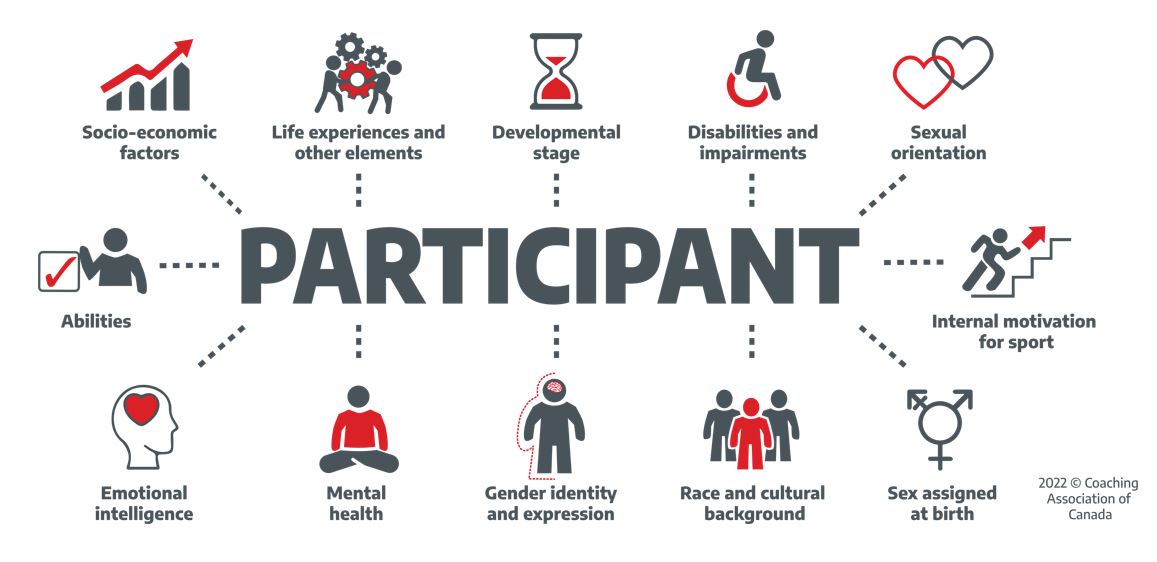
Individuality and Lived Experience
Another factor contributing to the culture shift that sport currently faces is recognizing the uniqueness of athletes as individuals. This means that every individual responds to coaching in different ways. The traditional coaching style may work for some athletes who may see extreme exercise, for example, as a valuable lesson or a push to make them stronger. However, others may see it as harmful to their physical and mental health and ultimately ineffective on their overall performance. Understanding the fine line between pushing athletes to reach their goals while ensuring that they are not being harmed in the process is a challenging task that coaches are faced with today. As such, providing coach education on empathy, openness to learning, and how to identify unique differences between athletes is integral to ensuring safe sport. During this transition, it is important to note that coaches are participating in this culture shift and learning alongside everyone else. Even at the highest level of basketball in the world, Toronto Raptors coach Brittni Donaldson posted to Twitter asking for advice on how to ensure that athletes are being pushed but are not harming themselves in the process. As these examples suggest, a “one size fits all’ approach to coaching will not be acceptable to the new generation of athletes. In short, know your athlete.
Actions Taken Towards Safe Sport
Since 2014, the CAC has experienced a number of important milestones in its movement towards achieving safe sport for all. Here are some of the highlights.
1. CAC and CCES-led NSO Sexual Abuse in Sport Summit (2015)
The CAC-led safe sport summits have been key in understanding the concerns of sport stakeholders of provincial/territorial and grassroots sports organizations including sport leaders, sport administrators, coaches, officials, and volunteers. In 2015, an NSO Sexual Abuse in Sport Summit was led by the CAC and the Canadian Centre for Ethics in Sport (CCES). This summit focused on the need to raise the awareness and expectations of ensuring the safety and protection of all participants in sport. In this summit, the personal story of Manitoba hockey player Sheldon Kennedy was shared, including some of the reasons why his sexual abuse as a minor in the 1980s was not revealed until years later. There were discussions about Kennedy’s work in founding Respect Group and the subsequent Respect in Sport training that was developed and has since been accessed by over 1.7 million people in sport in Canada. This summit also covered the lessons learned from Scouts Canada, conversations about legal counsel for safe sport issues, and understanding vicarious liability.

In the News:
Outrage that Sparked the Safe Sport Summits

“Ex-ski coach Bertrand Charest gets 12-year prison sentence” by Morgan Lowrie, Globe and Mail, Dec. 8, 2017.
In the winter of 2014-2015, Canadian alpine ski coach Bertrand Charest was charged with fifty-seven counts of sexual abuse/exploitation over approximately twenty years. Of those fifty-seven victims, twelve were under the age of eighteen. In addition to working his way through club and provincial level organizations, Charest also worked with the national level Alpine Canada between 1996 and 1998. This was the tipping point that led to the hosting of a sport summit for NSOs in 2015, led by the CAC and the Canadian Centre for Ethics in Sport.
2. Responsible Coaching Movement Launches (2016)
Following the 2015 NSO summit in partnership with the CCES, there was a clear desire on behalf of the sport partners for continued leadership in safe sport to decrease incidents of maltreatment. These concerns ultimately led to the Responsible Coaching Movement (RCM). The CAC is committed to working with all sport organizations to adopt and implement supportive policies and processes to ensure safety and protection of athletes and coaches, which is why we lead the multi-phase, system-wide RCM in partnership with the CCES. With their support along with that of the national sport system, the RCM was launched in 2016, and to date over 900 sport organizations have taken the pledge to apply its three pillars to their daily operations. These pillars include the rule of two, background screening, and ethics training.
Figure 17.6 CAC’s Responsible Coaching Movement
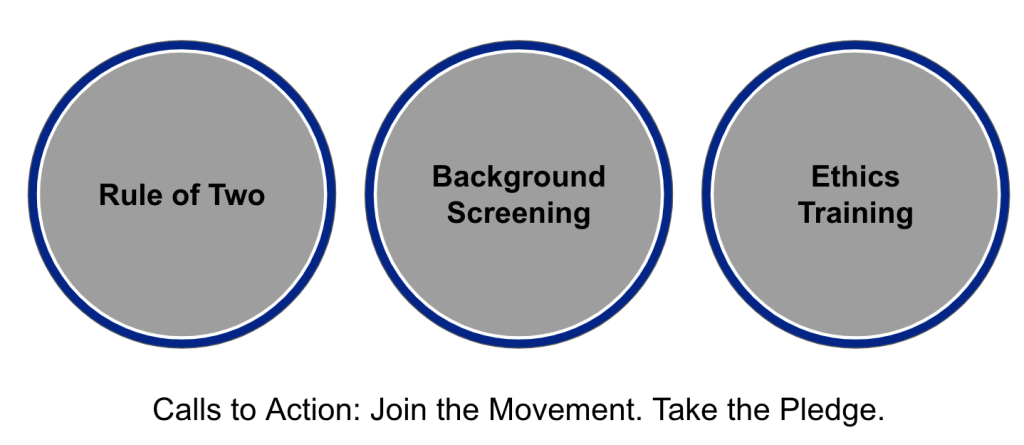
Rule of Two
The Rule of Two is a duty of care to ensure that all interactions between athletes and their coaches are open, observable, and justifiable. An open environment is one in which people can be seen and heard such as a meeting in a room with windows and an open door. A hotel room or car is an example of a closed environment. An observable environment is one in which parents and guardians or other people can see and hear participants practicing their sport, such as a glass window, open gym, arena, pool, etc. A justifiable environment is one in which it would be normal to see people like a coach and athlete together practicing sport such as in a gym, on the ice, on a field. A place that might not be justifiable is a coffee shop. While it is open and observable, it may not be justifiable.
Figure 17.7 The Rule of Two
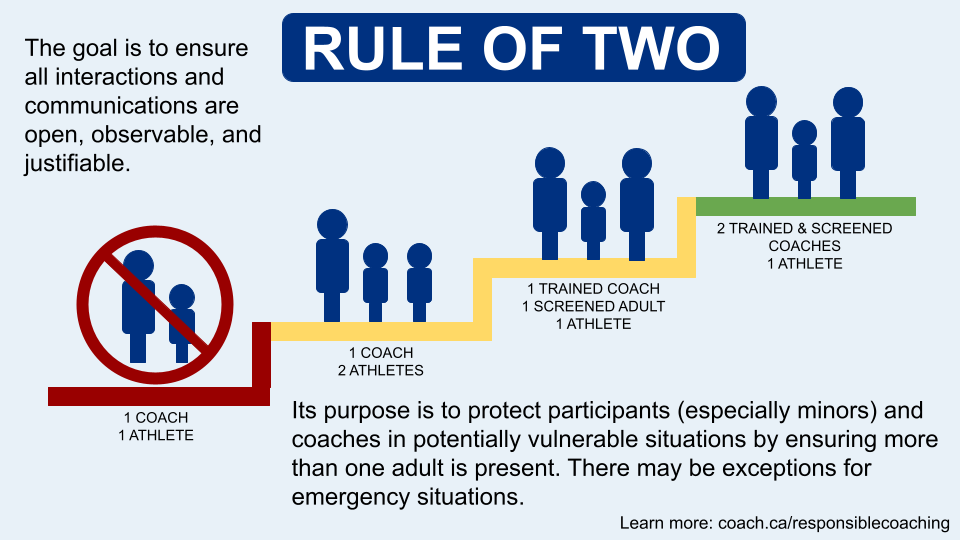
Background Screening
Background screening ensures that applicants to a sport organization such as employees, coaches and volunteers meet the important requirements to participate in sport activities. Screening includes comprehensive job postings, visible policies and processes, police information record checks, interviews, and reference checks, all of which are equally important. Organizations are encouraged to determine the level of risk of an applicant and define and document how they will screen candidates.
Ethics Training
The final piece of the RCM includes ethics training. This training is the NCCP Make Ethical Decisions (MED) eLearning module. Ethics training intends to equip coaches with the confidence and skills required to handle ethical and legal situations by applying a six-step process. MED training is required to be an NCCP trained coach, and the MED evaluation is required to be an NCCP certified coach.
3. CAC-led Safe Sport Summits across Canada (2019)
In February 2019, the Red Deer Declaration was signed at the Conference of Federal-Provincial-Territorial Ministers Responsible for Sport, Physical Activity, and Recreation. This declaration was a signed promise by sport ministers to commit to the prevention of harassment, abuse and discrimination in sport.
A series of thirteen CAC-led provincial and territorial safe sport summits were then held across the nation between March-April 2019. These summits were organized for stakeholders in Canadian sport to review the definition of harassment and abuse and to provide input on considerations for creating and implementing a universal code for safe sport.
These summits led to the federal-provincial-territorial agreement that all federally funded sport organizations would align with the Universal Code of Conduct to Prevent and Address Maltreatment in Sport (UCCMS) and implement the following:
- Develop a Code of Conduct which incorporates the definitions of maltreatment, duty to report, sanctions issues and record-keeping and ensures an independent third-party process for the review of reports or complaints and lead in investigations, if required;
- Implement mandatory safe sport training (April 1, 2020); and
- Launch an independent safe sport mechanism (launched in July 2021).
The CAC’s work on the implementation of the RCM built the foundation for additional legislative changes made by Canada’s then-Minister of Sport Kirsty Duncan in 2018 and 2019. In 2020, the UCCMS was launched as the culminating document with which sport organizations can address and prevent maltreatment, much of it based on the recommendations that arose from these summits.
4. CAC-led Safe Sport Summits across Canada (2020)
In March and April of 2020, over 25 coach interviews were conducted to determine the major topics that were to be addressed at the regional safe sport summits that year, despite the onset of Covid-19. Four regional safe sport summits were held virtually from August-September, held in partnership with the Canadian Sport Institutes and Centres delivering the NCCP Advanced Coaching Diploma. There was support for updates to be made to the Advanced Coaching Diploma by embedding safe sport principles into the curriculum. The top coaching concerns that arose in these discussions were:
- How to conduct training in online environments;
- Dealing with false allegations;
- The line of harassment, abuse and discrimination and high-performance sport;
- Financial challenges, (related to the rule of two); and
- “Fear culture” in general.
Finally, on September 22, 2020, the CAC and Own the Podium hosted a National Coach Safe Sport Summit that included 188 participants. There were five main needs addressed:
- Need for clarity and system alignment;
- Coaching support and sharing opportunities;
- Application of practical guidelines;
- Transformational learning versus transactional, and;
- Inclusion and diversity.
The Coaching Association of Canada’s Safe Sport Journey
Have a look at the timeline below to familiarize yourself with the safe sport-driven events that happened between 2015-2021. (Please note some of these are also highlighted in the Key Dates timeline at the beginning of the chapter.)
Figure 17.8 The CAC Safe Sport Journey 2015-2021
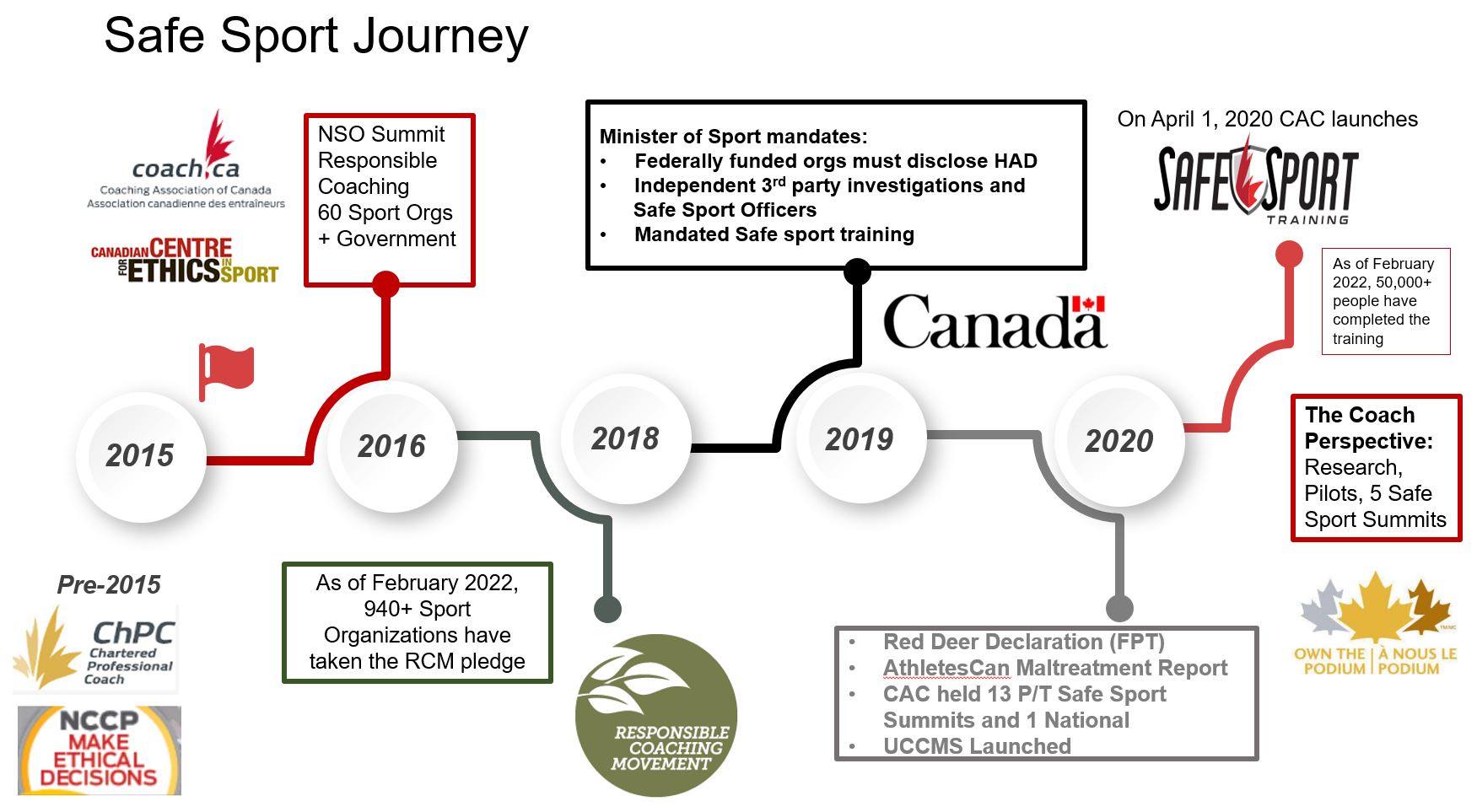
Current CAC Programs and Initiatives
One of the main recommendations put forward by coaches and sport organizers has been to put the dialogue surrounding safe sport into practice. Today, the CAC continues their dedication to supporting the implementation of the Universal Code of Conduct to Prevent and Address Maltreatment in Sport (UCCMS) by offering the following programs and initiatives.
1. The Responsible Coaching Movement
As of February 2022, over 940 sport organizations have taken the pledge to align their practices with the RCM’s three main pillars by ensuring the rule of two, implementing background screening and applying ethical training.
2. Key Partnerships
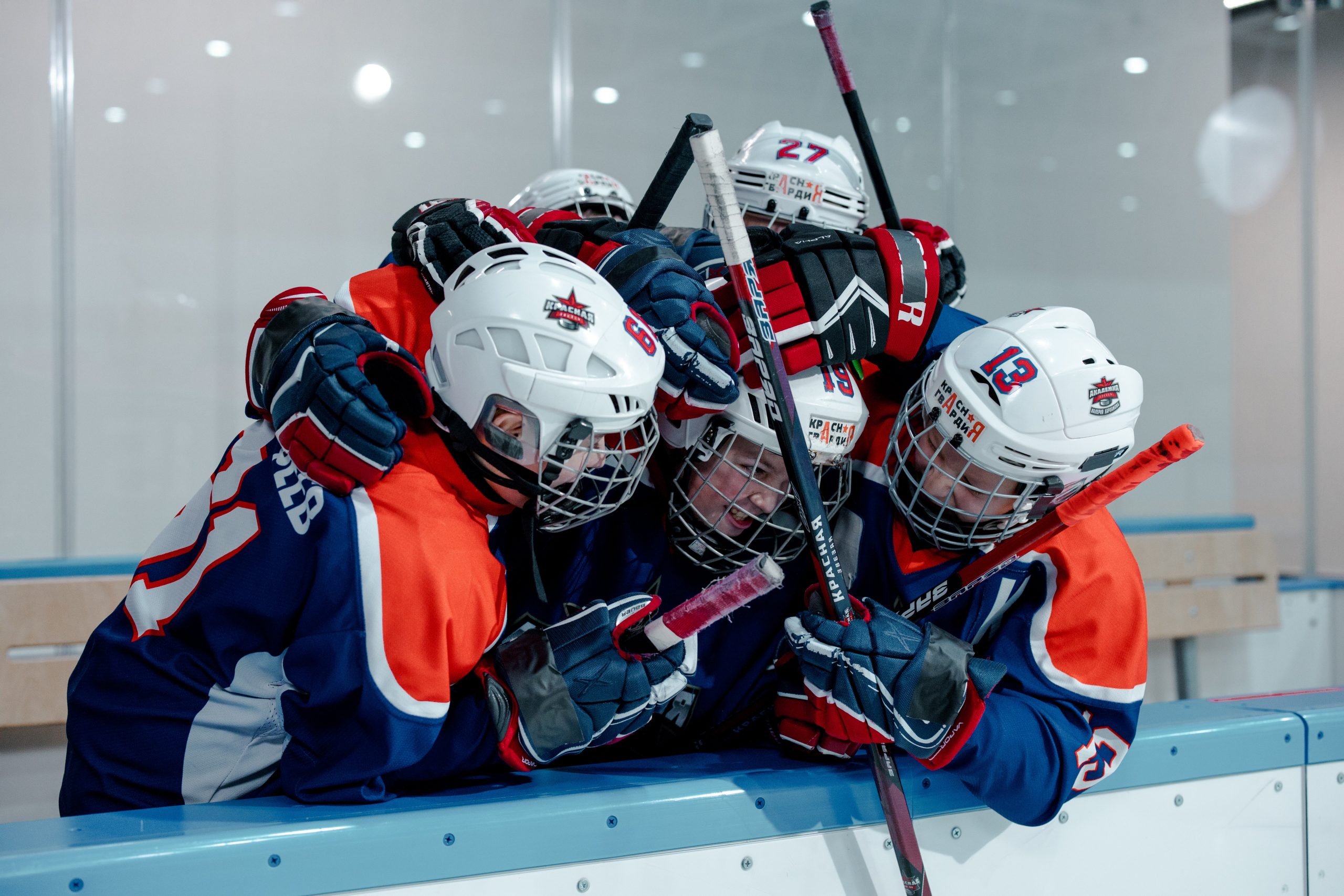
The CAC has also collaborated with the Canadian Centre for Child Protection (CCCP) that launched the Commit to Kids for Coaches training which focuses on the topic of grooming, how to recognize it, how to report it, and how to be proactive against it. Additionally, the CAC’s five-year partnership with Kids Help Phone is an initiative geared towards athletes themselves by offering valuable support services and resources to young people within the sport community in Canada.
3. Safe Sport Summits
By organizing multiple safe sport summits for sport stakeholders, the CAC continues to push for dialogue towards achieving greater safe sport goals.
4. Safe Sport Training
Following the impactful safe sport events detailed in the timeline above, Sport Canada mandated safe sport training and the CAC launched the free eLearning module on April 1, 2020. In alignment with the requirements of the UCCMS, the training is required for federally funded national sport organizations and specifically for athletes, people in direct contact with athletes, and decision-makers. The UCCMS training includes understanding the definitions of maltreatment, duty to report, third party independent reporting and investigations process, decisions, appeals and record keeping. The requirement presented no cost to the national sport system because it was funded by Sport Canada. As of February 2022, over 50,000 people have taken the CAC Safe Sport training.
5. New Sport Safety Department
Since 2015, the safe sport summits along with the RCM and other key events led to the creation of a Sport Safety Department for the CAC. In 2018 a Manager, Diversity and Inclusion was created. In 2020, this led to the creation of a Director, Sport Safety position which is comprised of three pillars: Equity, Diversity and Inclusion, Professional Coaching, and Safe Sport/Responsible Coaching Movement. The department is supported by a Manager, Sport Safety, Coordinator, Diversity and Inclusion and Coordinator, Professional Coaching. The Professional Coaching Program is aligned with the RCM as it requires coaches to be trained in ethics, complete an enhanced police information check, provide references, and read, agree to, and sign the CAC Code of Conduct and Ethics.
6. The Coach Perspective: A Safe Sport Review
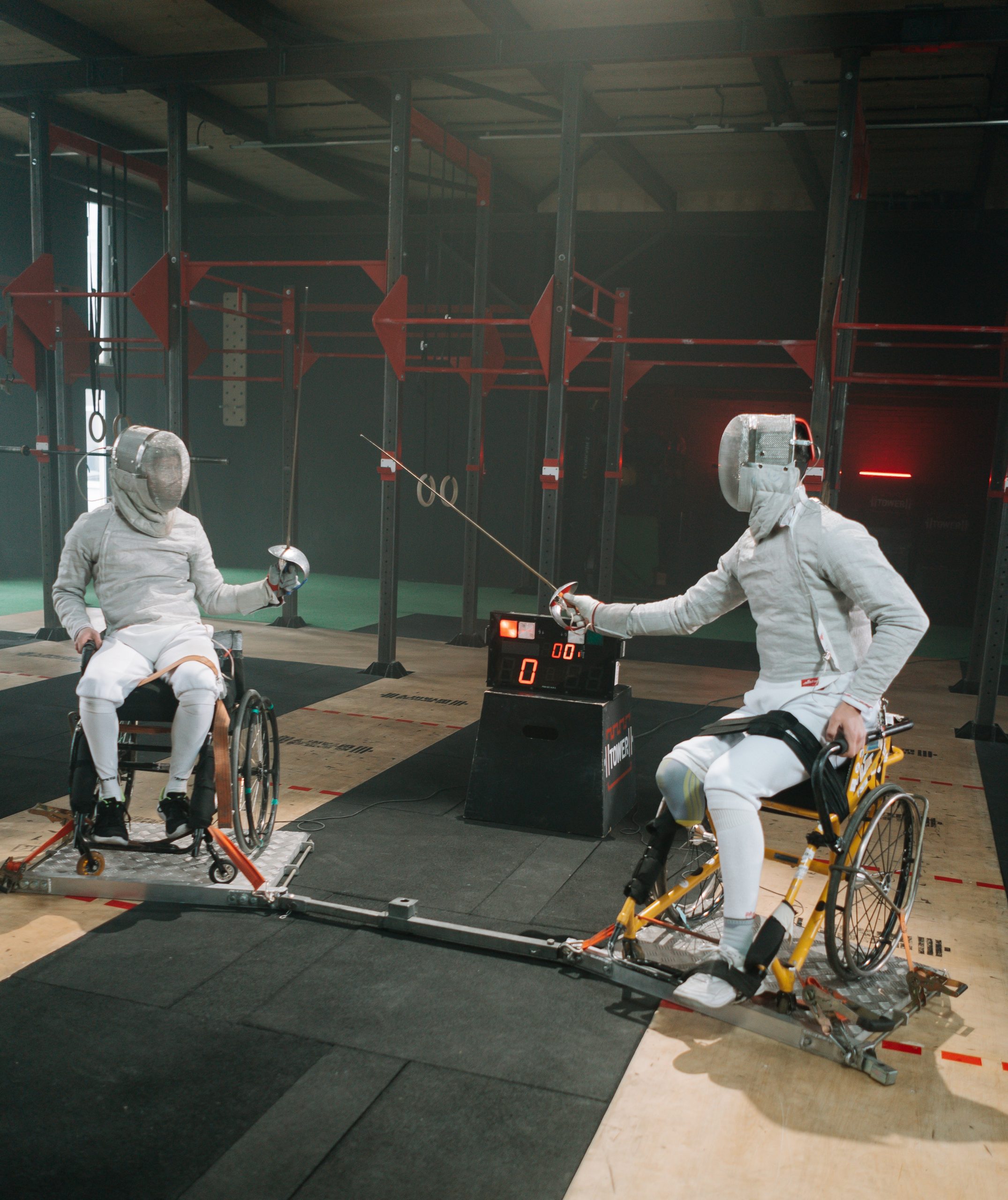
In 2021, the CAC completed a safe sport review that aimed to understand coaches’ perceptions on safe sport through one-on-one interviews with 76 participants and online surveys with over 500 participants.[4] Most coaches indicated they are familiar with their organization’s Code of Conduct and have reviewed it within the last year. It was clear that most coaches do believe safe sport is a priority within their sport, and they saw many positive aspects of safe sport, including educating various groups (athletes, coaches, parents). There was an element of fear and concern expressed by coaches regarding the potential for defamation that could result from the complaint process as it is currently perceived to be more in favor of athletes, not coaches. While most coaches concur that safe sport and high-performance can be integrated, they also think that there should be a separate definition of safe sport for high-performance. Coaches are confused by the different messages they have received on safe sport, so it is important to ensure that messaging coming from one or several sources is consistent and in line with best practices in safe sport. Recommendations are offered for sport organizations and the CAC.
The recommendations for sport organizations that arose from this review include implementation of a complaints process, offering communication and support, ensuring the rule of two and effective travel procedures, and establishing system-wide implementation of these goals. There were more specific recommendations for the CAC, as coaches asked for tools and resources on having difficult conversations, high-performance sport, para-sport and the Special Olympics, equity, diversity & inclusion, dealing with stakeholders outside of NSOs, educating other stakeholders, and navigating cultural differences.
7. Continued Prevention & Education Resources
The CAC offers an array of resources for sport organizers including various online training and workshops, pamphlets and infographics as educational and marketing tools, and a central website offering access to other important resources offered by Canadian NSOs and PTSOs. The cornerstone module of the NCCP is NCCP Make Ethical Decisions, which guides coaches through a 6-step ethical decision-making model, as well as a model on making decisions that are legal in nature, or where child protection services may be required. The training module is delivered by the PTCR as a workshop, and coaches are also evaluated on the content through an eLearning module hosted in the CAC Locker, which is a central online portal that maintains the records of coach training offered through the NCCP and its partners. The CAC works collaboratively with 65 NSOs and their provincial-territorial partners to support and facilitate the development and delivery of NCCP sport-specific training and certification programs for those looking to coach sports from bowling to soccer.
The CAC has also implemented “Communities of Practice (CoP)”, which is a high-value, low-cost initiative to connect people with a passion for learning, developing, and growing together related to their practice.[5] Whether that learning is focused on supporting professional development, advancing women’s leadership capacities in sport, or developing the learning capabilities of parasport coaches, a CoP can be a cost-effective way to impact learning and change. The CAC and the University of Ottawa have collaborated to prepare a model that provides sport organizations with a step-by-step approach to plan, train, design, implement, assess and maintain a Community of Practice focused on supporting long-term change. The model is for any organization implementing an initiative to support collective learning and will suggest tips, questions to consider, and will guide users through the process.
Another important initiative to note is the CAC’s work in targeting gender-based violence. In 2019, the CAC received funding from the Public Health Agency of Canada to target the problem of gender-based violence and teen dating violence. With this support, we developed and launched four modules entitled “Support Through Sport Series.” The first of the four modules in this series is “Understanding Teen Dating Violence,” which launched on June 1, 2021 and is a powerful resource for coaches to identify teen dating violence and support their participants and model healthy relationships. The three remaining modules will launch on June 1, 2022 and include Bystander Empowerment, Gender-based Violence in Sport, and Modelling Healthy Relationships.
Video 17.3 Isabelle Cayer: Support Through Sport Series
Video provided by Dr. Michael Van Bussel, Panel Moderator and Conference Chair, 2021 Safe Sport Forum; and Dr. Julie Stevens, Director, Centre for Sport Capacity, Brock University. Used with permission. [Transcript]
Conclusion
Our recent safe sport review showed us that coaches are looking for more specific tools and resources in a number of areas. In response to the recommendations from this review, the CAC is currently offering coaches new eLearning modules including “Understanding the Rule of Two” and “Anti-Racism in Coaching”. The CAC is also offering a full RCM refresh complete with an informational video and national campaign to expand the reach of this movement to the larger sport community. In addition, other NCCP modules that launched in early 2021 are Leading a Return to Sport and Mental Health in Sport.
The most recent safe sport module released by the CAC was NCCP Creating a Positive Sport Environment, released in October, 2021. This module covers some elements of maltreatment in sport, but serves to focus on how to use positive coaching strategies to create a positive sport environment, enhance safety, and improve learning and performance. A section on having difficult conversations is included within the module to provide additional tools for coaches.
It is our hope that by continuing to build educational resources and preventive practices that we can continue to lead in the journey towards achieving safer sport in Canada.

“Be mindful of your individual impact and your power to make change happen.”
-Author Unknown
Coaching Association of Canada (CAC). (n.d.a). Communities of practice – A how-to model. Retrieved December 9, 2021, from https://coach.ca/communities-practice-how-model
CAC. (n.d.b). Leading a return to sport participation. Retrieved December 9, 2021, from https://coach.ca/leading-return-sport-participation
CAC. (n.d.c). Mental health in sport. Retrieved December 9, 2021, from https://coach.ca/mental-health-sport
CAC. (n.d.d). NCCP creating a positive sport environment. Retrieved December 9, 2021, from https://coach.ca/nccp-creating-positive-sport-environment
CAC. (n.d.e). NCCP makes ethical decision. Retrieved December 9, 2021, from https://coach.ca/nccp-make-ethical-decisions
CAC. (2020, April 3). Safe sport training promo [Video]. Youtube. https://www.youtube.com/watch?v=DPhwZZ6x2uM
CAC. (2021, September 10). Safe sport review. Retrieved December 9, 2021, from https://coach.ca/safe-sport-review
Campbell, M. (2021, August 18). Exploiting Osaka’s vulnerability isn’t a solution to media’s swindling access. CBC Sports. Retrieved December 9, 2021, form https://www.cbc.ca/sports/opinion-naomi-osaka-media-1.6144374
Canadian Intergovernmental Conference Secretariat. (2019, February 15). Red Deer Declaration – For the prevention of harassment, abuse and discrimination in sport. Retrieved December 9, 2021, from http://scics.ca/en/product-produit/red-deer-declaration-for-the-prevention-of-harassment-abuse-and-discrimination-in-sport/
Donaldson, B [@brittni_d]. (2021, May 24). Coaches/Trainers/Mental Performance Specialists – would love to know any best practices around how you balance encouraging your athletes to dig deep & persevere through adversity (such an important lesson), yet ensuring they are not harming themselves in the process [Tweet]. Twitter. https://twitter.com/brittni__d/status/1396872341569908736
Edmondson, A. C. (2019). The fearless organization: creating psychological safety in the workplace for learning, innovation, and growth. Wiley.
Fendrich, H. (2021, May 31). Naomi Osaka withdraws from French Open, says it’s the best thing’ for her well-being. The Associated Press. Retrieved December 9, 2021, from https://www.cbc.ca/sports/tennis/naomi-osaka-withdraws-french-open-1.6047177
Kerr, G., Willson, E., & Stirling, A. (2019). Prevalence of maltreatment among current and former national team athletes. University of Toronto. 1-51. https://athletescan.com/sites/default/files/images/prevalence_of_maltreatment_reporteng.pdf
Lowrie, M. (2017, December 8). Ex-ski coach Bertrand Charest gets 12-year prison sentence. The Canadian Press. Retrieved December 9, 2021, from https://www.theglobeandmail.com/sports/more-sports/ex-ski-coach-bertrand-charest-gets-12-year-prison-sentence/article37268149/
Register-Mihalik, J., Baugh, C., Kroshus, E., Kerr, Z. Y, Valovich McLeod, T. C. (2017). A multifactorial approach to sport-related concussion prevention and education: Application of the socioecological framework. Journal of Athletic Training, 52(3): 195-205. DOI: 10.4085/1062-6050-51.12.02
Safe Sport eReader. (2021a, December 3). Cayer 2 sport is in a culture renovation [Video]. Youtube. https://www.youtube.com/watch?v=Vc4-Dy0yBeo
Safe Sport eReader. (2021b, December 3). Cayer 3 support through sport series [Video]. Youtube. https://www.youtube.com/watch?v=9r_u0DUkTBg
Athletes feeling understood, powerful, and present in the sport community with opportunities to feel safe and supported.
A call to action for sport organizations, parents, and coaches to enact responsible coaching across Canada – on and off the field.
Works to prepare coaches to confidently and skillfully handle ethical and legal situations by utilizing a six-step process.
A duty of care to ensure that all interactions between athletes and their coaches are open, observable, and justifiable.


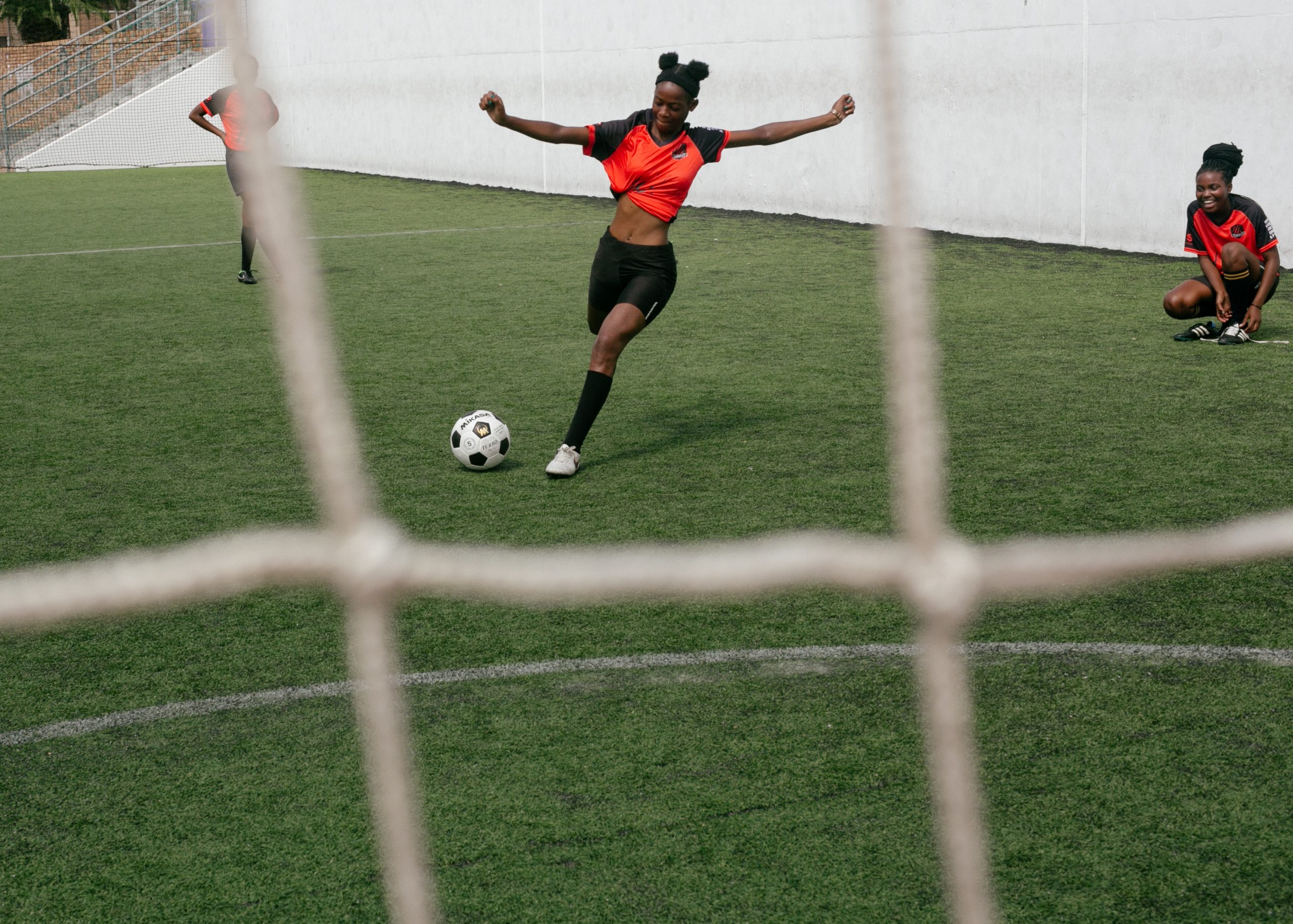

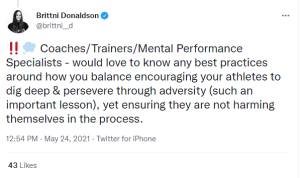


 Sources
Sources 